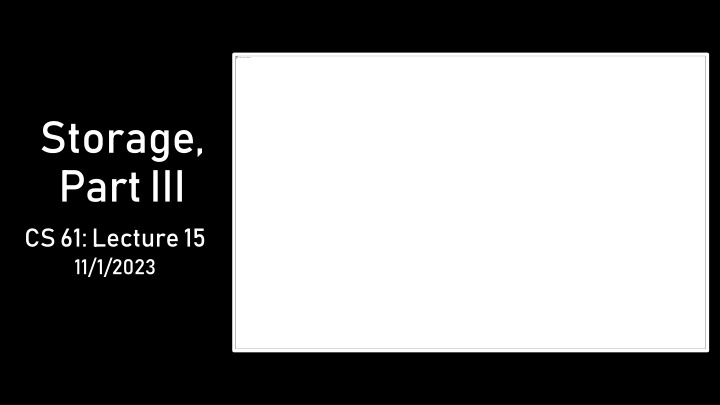Part III
The stdio library associates each FILE with a 4KB cache slot, managing reads and writes to optimize performance. Explore the concept of associating each FILE with two cache slots and how it enhances caching efficiency during file operations.
Download Presentation

Please find below an Image/Link to download the presentation.
The content on the website is provided AS IS for your information and personal use only. It may not be sold, licensed, or shared on other websites without obtaining consent from the author.If you encounter any issues during the download, it is possible that the publisher has removed the file from their server.
You are allowed to download the files provided on this website for personal or commercial use, subject to the condition that they are used lawfully. All files are the property of their respective owners.
The content on the website is provided AS IS for your information and personal use only. It may not be sold, licensed, or shared on other websites without obtaining consent from the author.
E N D
Presentation Transcript
Storage, Part III CS 61: Lecture 15 11/1/2023
Review of the stdio The stdio library associates each FILE with a single 4 KB cache slot During reading, when the file position moves outside of the currently cached block, stdio fetches the 4 KB-aligned 4 KB block that contains the new file position During writing, when the file position moves outside of the currently cached block, stdio: Flushes the currently cache write data (which may be less than a block in size!) Starts issuing writes to a new cache block that starts at the current file position (and thus may not be 4 KB-aligned) What is stdio wanted to associate each FILE with two cache slots instead of just one? stdio Cache struct _IO_FILE { int _fileno;//As returned //by the open() //syscall int _flags; //E.g., read-only, //read+write char* _IO_buf_base; //Other stuff . . . }; stdio stdio cache Read target Last chunk (possibly less than 4 KB) 4 KB file chunks
Review of the stdio The stdio library associates each FILE with a single 4 KB cache slot During reading, when the file position moves outside of the currently cached block, stdio fetches the 4 KB-aligned 4 KB block that contains the new file position During writing, when the file position moves outside of the currently cached block, stdio: Flushes the currently cached write data (which may be less than a block in size!) Starts issuing writes to a new cache block that starts at the current file position (and thus may not be 4 KB-aligned) What if stdio wanted to associate each FILE with two cache slots instead of just one? stdio Cache struct _IO_FILE { int _fileno;//As returned //by the open() //syscall int _flags; //E.g., read-only, //read+write char* _IO_buf_base; //Other stuff . . . }; stdio stdio cache Write target Last chunk (possibly less than 4 KB) 4 KB file chunks
Two-slot stdio Reading Each buffer stores cached data for a different 4 KB-aligned, 4 KB-large file region Once both slots are filled, a cached block is dropped and replaced if the new seek position isn t contained within either cached block Writing Each buffer stores cached data for a different region (up to 4 KB) that is being written A block is flushed when: It fills up with 4 KB of write data The seek position changes and is no longer the write offset in either cache block This approach generalizes to N slots! WHICH SHALL JOIN THE RACCOON? stdio Cache: A Possible Design struct _IO_FILE { int _fileno;//As returned //by the open() //syscall int _flags; //E.g., read-only, //read+write char* _IO_buf_base1; char* _IO_buf_base2; //Other stuff . . . }; A CACHE BLOCK MUST BE EVICTED Read targets that stay within either of these blocks will not trigger block pulls from the underlying storage device! stdio stdio cache Read target 1 Read target 3 Read target 2 Last chunk (possibly less than 4 KB) 4 KB file chunks
Two-slot stdio Reading Each buffer stores cached data for a different 4 KB-aligned, 4 KB-large file region Once both slots are filled, a cached block is dropped and replaced if the new seek position isn t contained within either cached block Writing Each buffer stores cached data for a different region (up to 4 KB) that is being written A block is flushed to storage when: It fills up with 4 KB of write data The seek position changes and is no longer the write offset in either cache block This approach generalizes to N slots! stdio Cache: A Possible Design THE RACCOON AWAITS struct _IO_FILE { int _fileno;//As returned //by the open() //syscall int _flags; //E.g., read-only, //read+write char* _IO_buf_base1; char* _IO_buf_base2; //Other stuff . . . }; CHOOSE WISELY Write targets that use one of these write offsets will not trigger flushes to the underlying storage device! stdio stdio cache Write target 2 Write target 3 Write target 1 Last chunk (possibly less than 4 KB) 4 KB file chunks
Multi-slot Caches A single-slot cache can be effective for many workloads (particularly sequential ones) However, a multi-slot cache will often perform better For example, at any given moment, a process will typically exhibit spatial and temporal locality for: The stack page containing the current function s stack frame One or more code pages that store the code for the current function Possibly one or more heap pages if the function manipulates heap objects A TLB with multiple slots can hold mappings for more of these hot pages! Multi-slot caches introduce some new questions Associativity: Associativity: Which cache slots can an incoming block map to? Eviction: Eviction: If the cache is full and needs to make space for a new block, which old block should be evicted?
Cache Associativity in a Cache with S S Slots In a fully fully- -associative cache associative cache, any block can be stored in any of the S slots In a set set- -associative cache associative cache, a block with address A can reside in a specific subset of the slots Ex: In a two-way set associative cache with S=4, a particular block can reside in one of two potential slots In that example, the cache might partition the block address space of the underlying storage into two equally-sized regions, such that blocks from a particular region are mapped to the same set in the cache In a direct direct- -mapped cache mapped cache, each block can only be stored by one slot Ex: A block with address A might map to the slot A % S The stdio cache for a particular file is single-slot, direct-mapped and fully-associative Underlying storage Cache Underlying storage Cache Underlying storage
Fully-associative two slot cache Tag Data read b3 write b2 write b2 read b1 Slot Tags A cache associates each slot with a tag If the slot is empty, the tag is meaningless If the slot if filled, the tag allows the cache to determine if a particular read or write request will be a hit for that slot For a cache that supports block-sized, block- aligned reads and writes, the slot tag is just the address of the block to read/write For a cache that supports block-unaligned reads or writes, tagging is more complicated Give example of a single-slot stdio cache in which the tag is the current write offset Give example of a two-slot stdio cache in which the tag is the current write offset, but when a write comes in you have to make sure that it wouldn t bleed into another cached block tag 3 2 Underlying storage Cache miss there s no block with tag 3! The request is a read, so pull from the underlying storage. cache isn t full yet, so no need to evict. writing to the underlying storage. b b3 3 is clean, so we could drop it for free! Cache miss there s no block with tag 2! The request is a write, so no need to pull from storage; also, the b2 is dirty, so evicting it would require Cache miss there s no block with tag 1! The cache is full, so we Cache hit there s a block with tag 2! must evict something.
Slot Tags Reading a file stdio stdio cache A cache associates each slot with a tag If the slot is empty, the tag is meaningless If the slot if filled, the tag allows the cache to determine if a particular read or write request will be a hit for that slot For a cache that supports block-sized, block- aligned reads and writes, the slot tag is just the address of the block to read/write For a cache that supports block-unaligned reads or writes, tagging is more complicated Consider a single-slot stdio cache In read mode, the tag is a 4 KB-aligned block address, even though the read address target may be non-4-KB-aligned In write mode, the tag is the current, possibly unaligned write offset tag Read target: 0x4000+0x800 Slot tag: 0x4000 Last chunk (possibly less than 4 KB) 4 KB file chunks Writing a file stdio stdio cache Write target: 0x4000+0x800 Slot tag: 0x4000+0x800 Last chunk (possibly less than 4 KB) 4 KB file chunks
Analyzing Caches using Reference Strings Many aspects of multi-slot cache design are independent of block address semantics, the type of the underlying storage, etc. We can abstract away those factors, analyzing cache behavior using a reference string reference string of access patterns ONE CHILD MUST GO Reference string of accesses 3 3 1 1 3 1 1 3 1 3 3 3 1 3 3 3 1 1 1 3 1 4 4 A B Circled numbers indicate cache misses Cache slots WHO JOINS THE RACCOON?
Analyzing Caches using Reference Strings Many aspects of multi-slot cache design are independent of block address semantics, the type of the underlying storage, etc. We can abstract away those factors, analyzing cache behavior using a reference string reference string of access patterns Eviction Eviction is the act of freeing a cache slot for use by a new block Direct-mapped caches have a trivial eviction policy just evict the old block in the slot which the new block maps too! Non-direct-mapped caches can use a variety of eviction policies For any reference string and cache of size S, the optimal eviction policy is one that always chooses to evict the block that won t be needed again for the longest time In practice, real access patterns are difficult/impossible to predict with complete accuracy Real eviction policies have trade-offs with respect to accuracy and efficiency
Eviction Policies Here are some common eviction policies for fully-associative caches: FIFO ( first in, first out ) FIFO ( first in, first out ) Evict the block that was fetched the longest time ago Possible implementation: In each tag, include the timestamp at which the block was fetched LFU ( least frequently used ) LFU ( least frequently used ) Evict the block that has been used the least often in recent history Possible implementation: Keep a linked list of all blocks, sorted by the last access time for each block LRU ( least recently used ) LRU ( least recently used ) Evict a block that hasn t been accessed in the recent epoch Possible implementation: In each tag, include an LRU bit; periodically reset all bits to 0 and then set a block s bit to 1 when the block is accessed For an N-way associative cache, each cache set is logically a fully- associative cache and can use a policy appropriate for such a cache In practice, variants of LRU are very common
Hit Rates vs. The Number of Cache Slots B l dy s B l dy s anomaly: anomaly: Adding more slots does not always increase the hit rate! Adding more slots to an LRU cache is guaranteed to improve the hit rate!
Memory-mapped IO With traditional file IO: The kernel s buffer cache stores file blocks in kernel memory System calls like read() and write() transfer data between user-level buffers and the kernel- level buffer cache blocks System calls incur context switch overheads! With memory-mapped IO: Process P selects a file f to be manipulated using memory- mapped IO The OS reads f s data into the buffer cache The OS configures P s page table to map f s buffer cache blocks into P s address space P can then read or write the file data using normal memory writes, without using system calls (and thereby avoiding context switch overhead!) Application code stdio cache fwrite() stdio in libc++ write() User Kernel Buffer cache Device driver Storage device
Memory-mapped IO With traditional file IO: The kernel s buffer cache stores file blocks in kernel memory System calls like read() and write() transfer data between user-level buffers and the kernel- level buffer cache blocks System calls incur context switch overheads! With memory-mapped IO: Process P selects a file f to be manipulated using memory- mapped IO The OS reads f s data into the buffer cache The OS configures P s page table to map f s buffer cache blocks into P s address space P can now read and write f s data using normal memory operations, without using system calls (and thereby avoiding context switch overhead!) Static data Code Buffer cache pages for f f Heap+stack Other stuff Kernel memory User memory Stack Heap Physical RAM Static data Code Process X s virtual memory
Memory-mapped IO With traditional file IO: The kernel s buffer cache stores file blocks in kernel memory System calls like read() and write() transfer data between user-level buffers and the kernel- level buffer cache blocks System calls incur context switch overheads! With memory-mapped IO: Process P selects a file f to be manipulated using memory- mapped IO The OS reads f s data into the buffer cache The OS configures the P s page table to map f s buffer cache blocks into P s address space P can now read and write f s data using normal memory operations, without using system calls (and thereby avoiding context switch overhead!) //Example: Reading a file using //memory-mapped IO. int fd = open( file.txt , O_RDONLY); size_t size = filesize(fd); char* file_data = (char*) mmap(size, PROT_READ, fd, 0); //The `size` bytes of virtual //virtual memory starting at //`file_data` are now mapped to //the file s buffer cache blocks! size_t n = 0; char buf[1]; while (n < size) { memcpy(buf, &file_data[n], 1); //Reads the file data: //no system call needed! n += 1; } munmap(file_data, size); close(fd);
Files: Random Access vs. Stream Linux-like kernels use the file descriptor abstraction to expose many resources (e.g., files, raw storage devices, keyboards) However, a random access random access file has a file position, is seekable, has a finite size, and is typically mmap-able In contrast, a stream stream file does not have a file position, is not seekable, is not mappable, and may be infinite in size The most common example of a random access file is a file that resides on a persistent storage device like an SSD Examples of stream files are keyboard streams and network streams that are connected to remote computers
Special Files on Linux Linux defines a variety of fake files that are useful for testing/debugging programs (or providing dummy files to programs that insist on accepting files as inputs/outputs) /dev/null contains nothing Any read will return EOF Any write will succeed (but have no real side effect) Helpful if you want to run a program but discard the input: prog in.txt > /dev/null /dev/urandom contains random data that the kernel generates on the fly A read will return the next bytes of random data A write will add the written bytes to the kernel s entropy pool /dev/zero contains zero bytes that the kernel generates on the fly A read will return zero bytes A write will succeed (but have no real side effect, similar to writing to /dev/null)

















